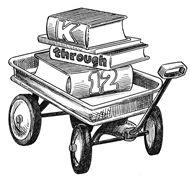- Education
- K-12
CEOs and governors are celebrating because most states have adopted standards-based reform and built testing programs to assess school performance. But their apparent victory is hollow. K–12 standards, which business leaders hoped would establish what every child needs to know to become a self-supporting and informed citizen, have come to mean something quite different.
Most state standards have no empirical basis. Standards have been developed as airy visions that satisfy all factions of the professional education community. Enthusiasts for different subjects—American versus world literature, various arts, and so forth—have all found secure places for themselves.
This shift in the meaning of standards is evident in states such as Washington that endorse standards but cannot agree on how schools will be held accountable. Business leaders are discovering that the groups that developed state standards were never asked whether they could prepare most or all students to meet the standards. People who developed standards in this way are understandably skeptical about taking firm action toward failing schools or districts. Maybe the aspirations were too ambitious and should be amended or their application delayed for a generation or so. Maybe teachers need a lot more training and experience. Maybe public spending on schools should double or triple.
Business people, who think standards should be explicit about what every child must know at a certain age if he or she is to become a participant in economic life, take a harder line. By their logic, temporizing is irresponsible. If children in a school are not meeting standards, something must be done immediately. There is no time to wait until teachers and administrators "come around." Under this logic, standards are promises made by the state and the state has an obligation to provide schools that can teach students successfully.
Business leaders need to stop congratulating themselves and start insisting that standards be built correctly. In many states, they will have to start over.
Evidence-based literacy and mathematics standards, particularly at ages nine and thirteen, could be created, but they would be more modest in scope than the airy visions endorsed by most states. It is hard to see how any state could prove that children's futures would be blighted if they did not know specific facts about history, arts, or even science at a particular age. But compared to the aspirational standards that most states have now set, those that are evidence-based would be compelling warrants for sustained and dramatic state action toward school improvement.
In the history of American public education, the standards movement might be seen as yet another loosely defined effort to stir up commitment and exhort teachers to higher performance. Or it might be seen as a turning point after which states—rather than political processes and customs—set goals for student learning. Much depends on whether business leaders and governors stop congratulating themselves and begin to look more closely at the treaties among educators that now pass as standards in most states.
















